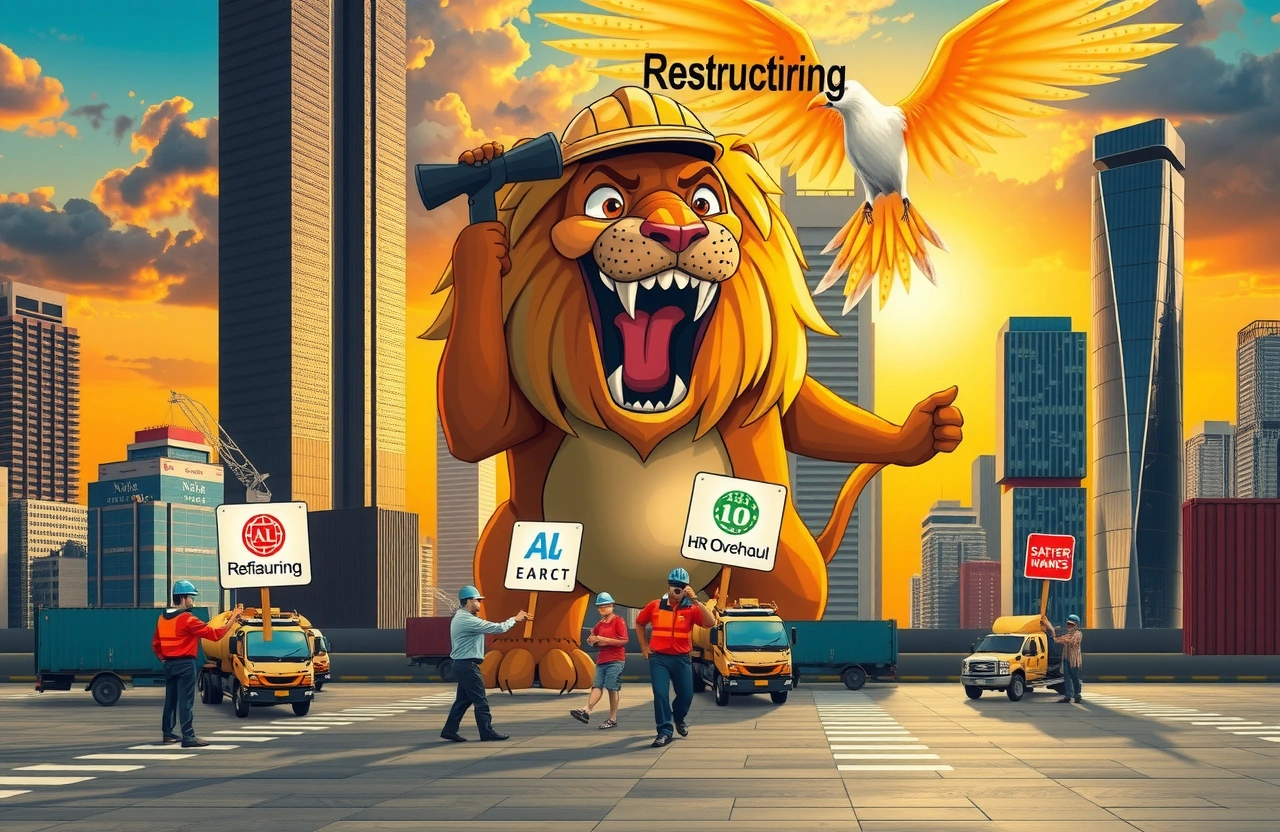The Unavoidable Transformation Sweeping Asian Boardrooms
Economic turbulence has become the crucible forging Asia’s next corporate evolution. Stock prices flutter like trapped birds while supply chains twist into labyrinthine complexity. Across Tokyo skyscrapers, Seoul industrial parks, and Singapore trading hubs, a single term echoes with renewed urgency: corporate restructuring. Once a reactive measure, it’s now a strategic survival blueprint. Hyundai recently announced splitting its fossil fuel division from future mobility units. SoftBank offloaded $29 billion in Alibaba shares to fund AI ambitions. Tata Group consolidated 96 subsidiaries into 10 verticals. With 73% of Asian CEOs anticipating recessionary pressures through 2025 according to PwC’s latest pulse survey, radical reorganization shifts from contingency to imperative.
The pandemic accelerated digital adoption threefold, but simultaneously exposed structural vulnerabilities. Inflationary tsunamis and interest rate storms now batter profit margins, forcing conglomerates to shed historical approaches. Unlike Western peers implementing scattered layoffs, Asia’s corporate dragons embrace holistic reinvention—rebuilding governance models, supply networks, and core competencies simultaneously. This generational corporate restructuring bridges resilience demands with disruptive innovation. Consider how Singapore’s Temasek reallocated $24 billion into decarbonization technologies while exiting traditional commodities—a microcosm of the transformative pivots rippling across boardrooms.
Economic Drivers Fueling the Restructuring Tsunami
The convergence of macroeconomic tempests leaves Asian corporations navigating uncharted territory. Three gale-force winds significantly influence the corporate restructuring surge.
Cascading Global Economic Pressures
- – Multispeed inflation crippling input costs: Raw materials up 18% year-on-year regionally, squeezing manufacturers
- – Rate hike domino effects: Bank of Japan’s policy shift triggering corporate debt refinancing crises
- – Currency volatility: Yen and Won depreciation increasing dollar-denominated liabilities exponentially
Mitsubishi Group’s exposure to yen weakness necessitated emergency debt renegotiations, demonstrating how currency fluctuations force balance sheet reorganization. Similarly, Korean chaebols like LG surprisingly monetized real estate holdings to offset FX losses.
The New Geopolitical Calculus
Tariff escalation and tech containment policies fracture once-reliable trade corridors. Vietnam’s manufacturing boom shriveled as US tariffs impacted 30% of electronics exports. Semiconductor titans like TSMC now implement dual-supply-chain strategies: maintaining Chinese operations while accelerating Japan/Arizona expansions. This bilateralization requires organizational restructuring through localized subsidiaries and specialized compliance teams. The China Plus One trend triggered $62 billion in supply chain relocations last year alone—forcing simultaneous portfolio simplification and geographic diversification.
Sector-Specific Shakeups Underway
Corporate restructuring manifests differently whether assembling smartphones or insuring risks. The transformations scorching across industries reveal fascinating patterns.
Manufacturing & Auto: Fissions and Tech-Fusions
Automotive giants dismantle legacy structures to survive the EV revolution. Toyota spun off its hydrogen development unit into a standalone entity while acquiring battery startups—a bifurcation strategy becoming commonplace. Foxconn revolutionizes its operational architecture through digital twin technology, reducing integration layers between HQ and 46 factories. Manufacturers adopt four restructuring principles:
- – Vertical disintegration of non-core processes
- – AI-enabled operational consolidation
- – Automation hubs replacing fragmented production lines
- – Regional self-sufficiency clusters minimizing cross-border dependencies
Sony exemplifies this approach, consolidating component manufacturing while licensing low-margin hardware production.
Finance & Tech: Digital Realignment Accelerating
Fintech disruption follows two recurring corporate restructuring themes: platform consolidation and blockchain integration. DBS Bank absorbed consumer banking into unified mobile ecosystems, phasing out 137 physical branches. Meanwhile, India’s Adani Group launched a corporate restructuring blueprint separating airports and ports infrastructure under new digital holding entities. South Korea’s Kakao reorganized corporate venture units into an innovation engine funded by IPO proceeds.
Core Pillars of a Successful Restructuring Framework
Financial De-risking Strategies
Corporate restructuring begins with balance sheet fortification before operational changes. Leading firms apply:
- – LBO-style asset recycling: Selling mature assets to acquire growth verticals
- – Equity-for-debt swaps creating headroom for investments
- – SPAC divestitures monetizing R&D without IPO timelines
Honda mitigated $12 billion debt through energy infrastructure divestments while acquiring S.E.A mobility platform.
The Human Architecture Rebuild
Workforce realignment extends beyond headcount reductions. Samsung transformed hiring pipelines toward AI literacy by creating internal tech academies—a $3.3 billion equation replacing hierarchical layers with skill clusters. Four human capital priorities emerge:
- – Cross-functional pods replacing departmental silos
- – Automated routine tasks freeing talent for innovation
- – Gig economy integration for variable cost models
- – Retention packages focused on retraining versus golden handcuffs
Analysts at Morgan Stanley Asia note distressed firms allocating 47 days average severance outperform restructures by 26% post-transition.
Navigating Execution Minefields
Corporate restructuring falters without anticipating landmines. Cultural rigidity ranks highest—Korean and Japanese firms face generational resistance when dismantling keiretsu structures. Regulatory friction causes 42% transitions to stall, evidenced when Indonesia blocked GoTo’s super-app restructuring over monopoly concerns. Compliance strategists recommend:
- – Phased implementation allowing regulatory approvals per block
- – Pre-emptive antitrust audits before announcement
- – Dual-branded legacy operations during transitions
The Restructured Enterprise Blueprint
Tomorrow’s Asian conglomerate resembles interconnected micro-enterprises rather than monoliths. Corporate restructuring pioneers cultivate four distinct operating models simultaneously: venture incubators for innovation, profit-center SaaS for servicing functions, remote-first operations for talent access, and asset-light partnerships. Reliance Industries perfected this quartet—Jio platforms’ fintech ecosystem funds traditional energy pivots while retail arms provide consumer data streams. AI governance layers bind these elements without bureaucratic drag.
Transformative Preparation for the Next Decade
Corporate restructuring efforts extend beyond immediate financial triage into fundamental capability building. Firms establishing digital twins before launch reduce integration failures by 59%. Others deploy predictive analytics to identify future restructuring triggers. Tata Group employs machine learning mapping commodity markets against geopolitical indicators to preemptively tweak organizational designs. Forward-planning enterprises conduct resilience audits assessing climate impacts, succession vulnerabilities, and tech disruption readiness. This proactive approach transforms restructuring from crisis response to continuous evolution—the very essence of corporate longevity amid volatility.
Corporate restructuring presents unprecedented challenges yet unlocks evolutionary potential. Leaders merging decisiveness with visionary compassion will emerge stronger. Assess immediacy: Begin supply stress tests today, map regulatory exposure tomorrow, then build stakeholder consensus. Survival favors businesses transforming corporate architecture before walls start crumbling. Seize restructuring not as cost-cutting exercise but transformation catalyst—that pivot makes giants future-proof.



